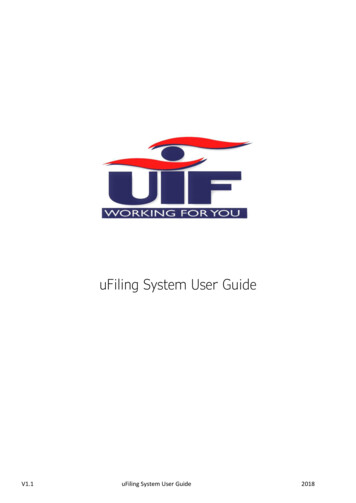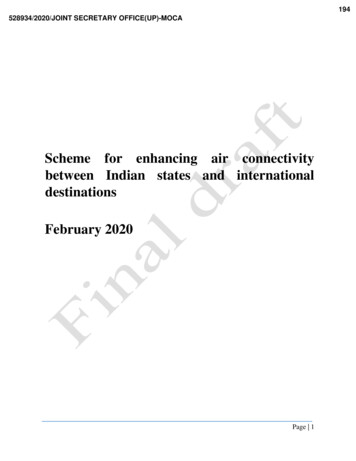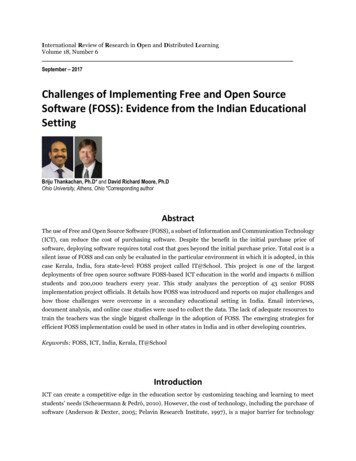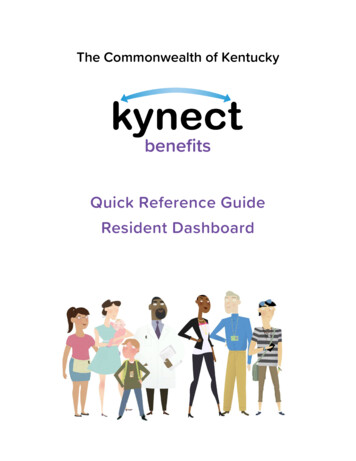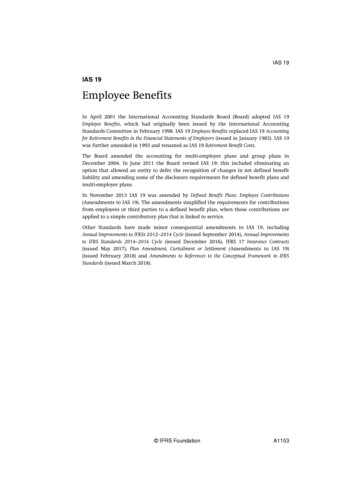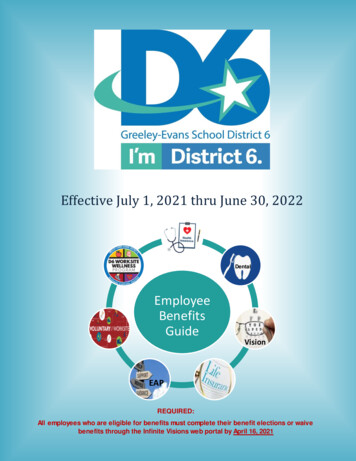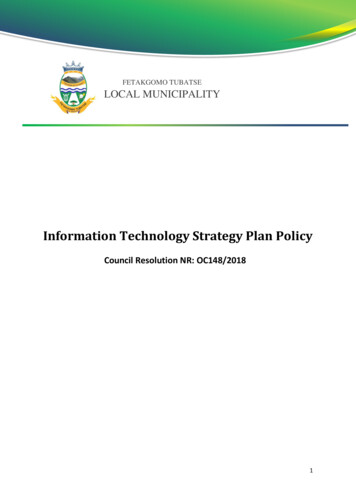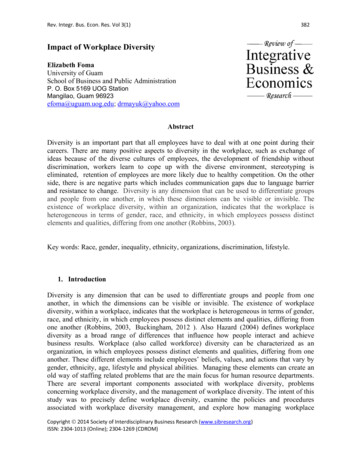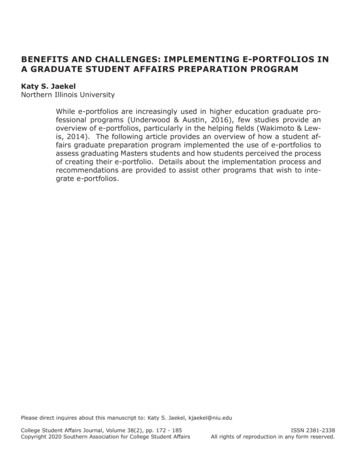
Transcription
BENEFITS AND CHALLENGES: IMPLEMENTING E-PORTFOLIOS INA GRADUATE STUDENT AFFAIRS PREPARATION PROGRAMKaty S. JaekelNorthern Illinois UniversityWhile e-portfolios are increasingly used in higher education graduate professional programs (Underwood & Austin, 2016), few studies provide anoverview of e-portfolios, particularly in the helping fields (Wakimoto & Lewis, 2014). The following article provides an overview of how a student affairs graduate preparation program implemented the use of e-portfolios toassess graduating Masters students and how students perceived the processof creating their e-portfolio. Details about the implementation process andrecommendations are provided to assist other programs that wish to integrate e-portfolios.Please direct inquires about this manuscript to: Katy S. Jaekel, kjaekel@niu.eduCollege Student Affairs Journal, Volume 38(2), pp. 172 - 185ISSN 2381-2338Copyright 2020 Southern Association for College Student AffairsAll rights of reproduction in any form reserved.
173Many have called for curricular reformswithin graduate student affairs preparation programs to better prepare future practitioners. These calls included newstudent affairs professionals having specific skill sets such as finance and budgetingexperience, legal knowledge, and proficientwriting skills (Herdlein, 2004). Others haveindicated the need for the development ofbroader initiatives, such as aiding in thecreation of a student’s professional identity, making formal curriculum applicable topractice (Renn & Jessup-Anger, 2008), possessing a knowledge base regarding institutional inter-workings (Magolda & Carnaghi,2004), and having a broad knowledge basein counseling skills (Kretovics, 2002). Given the vast needs of the field, it is criticalthat graduate preparation programs provideeducation on both specific skill sets and theability to connect theory-to-practice.To address the calls for adequate preparation of student affairs administrators, andto provide a framework for student affairswork, ACPA: College Student Educators International (ACPA) and NASPA: StudentAffairs Administrators in Higher Education(2015) developed a document outlining 10competency areas for student affairs educators. These areas of professional competency highlight foundational historical, philosophical, and theoretical knowledge basesand skills such as assessment, evaluation,and more recently, the use of technology.While these areas of professional competencies serve as a guide for student affairs educators and graduate preparation programsto prepare new professionals, some scholars are critical of using only a competency-based approach. For instance, Renn andJessup-Anger (2008) stated that graduatestudent affairs preparation programs shouldattend to the “cognitive, interpersonal, andintrapersonal development” and “students’ability to see their own education and professional development as object, ratherthan subject” (p. 330). Focusing solely on acompetency-based education system “runsthe risk of privileging certain epistemologi-College Student Affairs JournalVol. 38, No. 2, 2020cal and ontological frameworks to the exclusion and detriment of others” (Eaton, 2016,p. 576). Graduate preparation programsneed to focus on both the development ofprofessional competencies and the development of holistic measures to assess graduate students learning.One way to better prepare professionals is the implement of e-portfolios intograduate preparation programs (Denzine,2001; Herdlein, 2004; Janosik & Frank,2013). E-portfolios are an increasing trendin graduate preparation programs in higher education (Underwood & Austin, 2016).E-portfolios serve as a space where students can make meaning of their academicand professional experiences by showcasingtheir abilities to connect theory and practice. They can also serve as important toolsfor career development (Garris, 2007) andhelp graduates communicate their skill toemployers. Given the possibilities e-portfolios provide, faculty at Castle University’s(pseudonym) Higher Education and StudentAffairs (HESA) program decided to pilot theuse of e-portfolios as a culminating experience for graduating master’s students.This article provides a case study of howfaculty engaged in curricular reform by instituting the use of an e-portfolio assessment to better prepare graduating studentaffairs educators. The following will providean overview of e-portfolios, informationabout implementing e-portfolios, reflectionsfrom students on their experiences, andrecommendations for integrating e-portfolios into other programs. Findings discussedhow e-portfolios allowed students to reflecton their education, provide opportunities toshowcase multiple skill sets, and provide anongoing medium for professional development.Overview of E-portfoliosDeemed a high impact practice by theAssociation of American Colleges and Universities (AAC&U), e-portfolios provide students opportunity to actively engage in theirlearning, provide opportunity for reflection,
Implementing E-Portfoliosand illustrate course, programmatic, andeven university learning outcomes (Watson,Kuh, Rhodes, Light, & Chen, 2016). E-portfolios in higher education are used for bothformative and summative assessments,career searches, and spaces to showcaseaccomplishments (Barrett, 2006; Wang,2010). With increased technology, highereducation has moved more towards digitalor electronic portfolios (e-portfolios) due tothe ease of sharing and updating material(Lin, 2008), and their ability to showcasemultimedia (Ring, Weaver, & Jones, 2009).They allow faculty and institutions to easilycollect and assess student work, development, and growth (Janosik & Frank, 2013).There are three primary types of e-portfolio systems: assessment, learning-based,and professional and/or career portfolios.An assessment-based e-portfolio “demonstrates institutional accountability andserves as a vehicle for institution wide reflection, learning and improvement (Kahn,2001, p. 136). Here, programs or institutions can use the e-portfolio to assess students’ growth, competency, and knowledge.These e-portfolios can support and illustratecompetency or accomplishment of programsand objectives (Buyarski & Landis, 2014).Learning-based e-portfolio systems focus on learners’ reflections of their learningprocess. The goal of this type of systemis to support student learning with the useof critical reflection (Garis, 2007). Becauselearning is fluid, reflecting and representingwhat and how one knows is important in thelearning process (Cummings, 2006). Thistype of e-portfolio allows students to evaluate themselves, reflect upon their own learning, growth, and engage in critical thought(Denzine, 2001; Garis, 2007). These typesof e-portfolios are not institutional; rather,they serve as vehicles for students to reflecton their own learning experiences (Barrett,2007).Professional e-portfolios afford usersa platform to showcase accomplishments,experiences, and work samples for employment (Garis, 2007; Reardon, Lumsden, &174Meyer, 2005). These career developmentsystems are tools that allow students to beintentional and systematic in using evidenceand samples of work gained through academic preparation (Garis, 2007). Studentscan send their e-portfolios to potential employers who will be able to see academicpreparation, work experiences, and othercritical artifacts that illustrate students’ capabilities.While there is much scholarship one-portfolios generally, there continues to bea gap regarding the use of e-portfolios inthe helping professions (Wakimoto & Lewis, 2014), or those professions that assistin academic and nonacademic developmentand growth (Reynolds, 2009), including thestudent affairs profession. While e-portfolios are increasingly used within graduatepreparation programs (Underwood & Austin,2016) only a few studies serve to provideconcrete “pathways” or overviews of implementation of e-portfolios (Wakimoto & Lewis, 2014). According to Janosik and Frank(2013), the implementation of e-portfoliosin their student affairs graduate programswas “powerful and meaningful, particularlywith the job search process” (p. 18). Theydiscussed that students reported some difficulty learning the platform and adaptingto change within the curriculum. Studentsreported that crafting their e-portfolio tookmore time than they expected and concernabout the ambiguity of what the finishedproduct would look like.The students,however, shared their creation of e-portfolios added value to their graduate experiences. Given the benefits, many studentaffairs graduate programs are implementing e-portfolios, however there are gaps inthe literature regarding the implementationprocess for graduate student affairs programs.Overview of the CaseThe site, Castle University, a Midwestpublic research institution, enrolled justover 13,000 undergraduate students andnearly 5,000 graduate students. At the in-
175stitution, 57% of students were white, 14%were Hispanic and/or Latino/a, and 13% ofstudents were Black or African American.The HESA program historically focused onAdult and Continuing Education. However,since 2014, the focus of the masters program shifted to focus more on higher education and student affairs administration.This shift was intentional as it better alignedwith students’ goals and the larger goals ofthe student affairs field.The HESA program enrolled about 50masters students, half were first-year masters students, half were second years, andnearly all students were full-time. Full-timemasters students typically took two yearsto complete coursework and most had agraduate assistantship. The students in theHESA program were more diverse than thelarger university with over 45% of studentswho identified as students of color.Despite a lack of literature detailing howe-portfolios are implemented in a helpingprofession (Wakimoto & Lewis, 2014), theprogram faculty at Castle University’s HESAprogram decided to move forth with the implementation of e-portfolios. Previously,faculty expressed concern about the use ofa summative assessment, a research paper,as the capstone experience for the master’s program. The 20-25 page capstoneresearch paper did not require original research; rather, it served more as a literaturereview on a topic of students’ choice. Bothfaculty and students felt that the researchpaper did little to showcase the variety ofskills, knowledge, and competencies students acquired during their master’s program. Moreover, while the paper’s intentwas to allow space for students to connecttheir coursework and theory to practice,faculty complained that praxis was rarelyshowcased.While faculty had discussed movingtowards an e-portfolio system for sometime, during the spring semester of 2016,faculty decided to pilot the use of e-portfolios. Students were given a choice onwhich capstone course they enrolled; theyCollege Student Affairs JournalVol. 38, No. 2, 2020could choose either the e-portfolio sectionor the research paper section. Because thee-portfolio was a new initiative, and because faculty had not prepared students toretain their coursework, projects, or assignments to use as artifacts in the e-portfolios,students were given an opportunity to optout if they wished. While faculty could havewaited to implement the e-portfolios with anew cohort of students, they did not wantto wait another two years for this to occur.A total of 13 students chose to enrollin the e-portfolio capstone section and 12enrolled in the traditional research capstonepaper section. The e-portfolio section wasstructured as a weekend course that meton four Saturdays throughout the semester. Each class lasted eight hours and wasco-taught by the author and another otherfaculty member. Students were required touse the web platform, Weebly, a free blogging site that they could customize. Faculty wanted to use a site that was free andthat students could take with them aftergraduation. While the university had otherplatforms (e.g., LiveText and Blackboard),Weebly was chosen due to its ease and affordability.The e-portfolio capstone had three primary requirements: students needed toshow artifacts that they had completedduring their Masters program, they had toillustrate reflection on those artifacts, andthe artifacts and reflection had to speak tothe five departmental outcomes.While faculty initially thought to use theACPA/NASPA (2015) areas of professionalcompetencies, they felt it was too many forstudents to work with. Program faculty decided to require students to use these fiveoutcomes for students to use as a “spine”of their e-portfolio, a guide to showcasing skills, dispositions, reflection, and outcomes. Overall, this e-portfolio project wasdesigned to be an assessment portfolio inwhich faculty would use the e-portfolio toassess levels of student learning.
Implementing E-PortfoliosArtifact CollectionStudents were asked to select artifactsfrom coursework, assistantships, internships, volunteer work, or from any otherprofessional accomplishment to showcaseartifacts that would connect to each of thefive departmental outcomes. The department outcomes students were expected touse were:(1) Apply historical, social and philosophical foundations of higher education to the practice of higher education,(2) Apply learning and developmenttheories to diverse practice settings inhigher education,(3) Utilize a theory-to-practice model todevelop and plan programs in diversesettings, (4) Apply principles of assessment/evaluation to the practice of higher education,(5) Critique and apply research findingsto the practice of higher education.Because e-portfolios can showcase audio,visual, and other multimedia artifacts, students in the e-portfolio section were encouraged to use a range of artifacts. Theywere encouraged to show presentations,audio and visual artifacts, programs theydesigned, and/or other initiatives they thatillustrated a connection to each outcome.They were required to have at least one artifact for each of the five outcomes.Artifact ReflectionsOnce students selected their artifacts,they were asked to provide critical reflection on it, and how the artifact(s) providedmet each of the outcomes. Students wereencouraged to discuss how their knowledgeand/or practice was enhanced or changedfrom their specific artifact. Students weretold that these reflections did not have tobe positive; that is, students did not needto only present “successful” papers, or artifacts. Instead, they were encouraged toshow products that illustrated growth intheir coursework, assistantships, and otherlearning contexts.176AssessmentThe program’s faculty assessed thee-portfolios. Each e-portfolio had two faculty members who reviewed it, scored it onthe descriptive rubric, and then sent the rubric back to the two course instructors. Therubric consisted of five primary categories:Artifact selection, Artifact analysis and Reflection, E-portfolio Organization, WritingConventions, and Style and Delivery. Eachcategory was assessed on a scale of exemplary, proficient, emerging, and unsatisfactory. If two faculty disagreed on whetheror not the e-portfolio was passable, a thirdfaculty member reviewed it.Research DesignThis study utilized a case study approach, which examines “a phenomenon ofsome sort occurring in a bounded context”(Miles, Humberman, & Saldaña, 2014, p.28). Data was collected through observations of classroom sessions, semi-structuredinterviews (Patton, 2002), and through document analysis. This studied aimed to explore how students experienced the e-portfolio process and how they made meaningof their learning while creating their e-portfolios.ParticipantsAfter receiving university IRB approval,students enrolled in the e-portfolio sectionof the capstone course were solicited forparticipation. Of the 13 students enrolled inthe e-portfolio section, eight agreed to participate. Seven of the participants identifiedas women, and four identified as studentsof color. Each participant was in their finalsemester of their Masters program.Data Collection and AnalysisThree forms of data were collected: observations, interviews, and artifacts (e-portfolios). Data were collected through classroom observations of the e-portfolio classsessions. Observations took place on three,eight-hour long classes. During these classsessions, observations consisted of creating
177descriptive field notes and a summary ofthe observation after each class (Merriam,2009).Semi-structured interviews (Patton,2002) included two, hour-long interviewsthat centered on participants experiencesconstructing and reflecting on their e-portfolio. The first round of interviews lastedbetween 60-90 minutes. The second roundof interviews also spanned 60-90 minutes.The topics of questions included how students constructed their e-portfolios, whythey included particular artifacts, how theydesigned their e-portfolios, what benefitsand challenges they saw, and their overallexperiences in the e-portfolio class.Lastly, participants’ e-portfolios werecollected and analyzed. The e-portfoliosincluded reflections on learning outcomes,sample work (e.g., papers, presentations,videos), and other information participantsthought was important (e.g., resumes,“about me” statements, and photographs ofthemselves at university events).Value coding was utilized (Saldaña,2016) in the analysis of the interview transcripts and observational data. Value codingreflects “a participant’s values, attitudes,and beliefs, representing his or her perspectives or worldview” (Saldaña, 2016, p.131). In utilizing values coding, themes ofparticipants’ values and beliefs, particularly around learning, were centered. Codingfocused on how participants talked aboutand illustrated in their e-portfolios beliefsand experiences about their processes. Forinstance, codes that emerged from dataincluded “confidence in competencies,” asparticipants discussed in both interviewsand in class feelings of pride and confidencein their abilities of meeting department outcomes.Document analysis was used for participants’ finished e-portfolios to help “uncover meaning, develop understanding, anddiscover insights” (Merriam, 1988, p. 118)regarding students’ experiences with constructing their e-portfolio, and how theymade meaning of their learning. DocumentCollege Student Affairs JournalVol. 38, No. 2, 2020analysis took place through a systematicreview of participants’ e-portfolios. Eachparticipant’s finished e-portfolio was readthrough in an iterative process wherebypatterns and themes within the data werenoted and categorized (Fereday & Muir-Cochrane, 2006). Similar to the analysis ofobservational and interview data, the benefits and challenges participants experiencedrelated to the process of developing theire-portfolio was focused upon.After the development of themes, Guba’s and Lincoln’s (1981) member checkingwas used to uphold trustworthiness. As patterns emerged during the analysis phase,a list of patterns were sent to a sample ofparticipants to examine. Participants wereasked to comment upon or correct as theysaw fit (Reason & Rowan, 1981). Triangulation of data from interviews, observations,and document analysis was used (Merriam,2009) to help further support findings thatemerged.Researcher PositionalityIt is important to discuss my own positionality as it pertains to this study. Duringdata collection for this study, I was a corefaculty member in the HESA program andco-taught the e-portfolio course with another faculty member in the program. I hadextensive training on implementing e-portfolios as both a learning tool and as an assessment tool in undergraduate educationand helped design the e-portfolio initiativefor the program. I had been using e-portfolios with students for over five years inprevious academic settings.LimitationsMy role as a faculty member, both inthe program, and as a co-instructor for thecourse, may serve as a limitation. Givenmy roles, participants may not have feltcomfortable being honest about their experiences crafting the e-portfolios. I mediated this by using multiple data sources andby explaining that participation in the studywas voluntary and participants could stop
Implementing E-Portfoliosat any point without consequence. Anotherlimitation is self-selection. Students wereable to choose which section they wantedto take. This could have led participants tohave a more positive outlook on creatinge-portfolios.FindingsThe following section will discuss thebenefits and challenges to the e-portfolioprocess identified by the participants. Thebenefits included: recognizing competence,connecting theory-to-practice, and showcasing skills. Challenges students identifiedincluded: being a “frightening” experience,a political process, and usefulness in jobsearch.Benefits of E-PortfoliosStudents shared many benefits to thee-portfolio process and with their final product. Participants liked how the e-portfolio illustrated tangible practices, events that theyparticipated in, and “proof” of their abilities.They indicated using the site to show faculty how they connected theory gained fromtheir coursework to their practice, how theywere able to show readers of their e-portfolios a variety of skills in diverse manners,and that it was something that they couldkeep long-term, for professional development and careers.Recognizing competence. Participants shared that the process of developingan e-portfolio allowed them to realize thatthey were knowers. During class, studentsdiscussed with each other that before theconstruction of their e-portfolio, they wereuncertain if they had met the outcomes laidout by the program, let alone the contentcovered in their coursework. As they talked with one another, they commented onhow the process of creating their e-portfoliogave them more confidence in their abilitiesto be student affairs practitioners. In an interview, one student, Maria, [all names arepseudonyms] offered, “I really didn’t thinkthat I had met those outcomes at first, likeat all.” But, as she found, analyzed, and re-178flected on her different artifacts, she sharedthat not only did she learn, she applied herknowledge in her assistantships and in theclassroom. Maria went on, “Like, I am prepared for the profession. I can see that nowthrough my artifacts.”In her interviews, Trisha shared she wasa little surprised that she had met the program outcomes. She stated,I think at first, I thought that there waslike a dissonance, like between the program outcomes and my work. At first, Ididn’t think I had really done anythingthat showed that I had met them [theoutcomes]. I guess I thought a lot ofmy program was just, like, writing papers in APA format. But, then I lookedat the competencies, and realized, yes,I did perform those things. I did learnthose things. I can do assessment. Itwasn’t until the e-portfolio that it reallysank in.As Trisha shared her experiences constructing her e-portfolio, she commented on howshe used the programmatic outcomes asher guide. While at first she assumed shehad not met the outcomes, she realized thatshe had done work that mapped onto them.She continued,Before, if someone asked me, “werethere times I did assessment?” I wouldhave said “no.” But now, you know, I’mable to answer that in a job interview,that yeah, actually I have. I have actually learned and performed assessment.I maybe didn’t realize it until I reflectedon the artifact.In the process of creating her e-portfolio,Trisha realized that not only had she learnedabout assessment, she had carried out assessment projects. This became apparentin class, as she offered to help another student come up with ideas for what he coulduse as his assessment artifact. She talkedwith him about her realization about howshe was doing assessment and helped himidentify different assessment projects thathe had done, too.
179Connecting theory-to-practice. Somestudents shared that they chose the e-portfolio project because they could “show” versus “tell” about their accomplishments. Onestudent, Vanessa, said she felt that, “I couldfinally show people my work, instead of justtell them about it.” Another student, Greer,echoed that sentiment:I used artifacts from my assistantship,which was great. Like, I showed thingsthat I had actually done. Like, here ishow I used challenge and support theory, here is where I was developmentalwith my staff, here is how I did assessment. I guess I felt like I could giveproof, you know? Proof that I can usewhat [faculty] taught me.For Greer and Vanessa, they liked that theire-portfolios could show viewers their abilities.Mara, who was a graduate assistant inresidence life, shared that she saw benefitsin creating the e-portfolio because it showedher use of theories in practice. She offered,I was glad I could show work from outside of the classroom. I used two programs that I did for my assistantshipand was actually able to show how Iused the theories. I think that is whatI liked best, showing how I had takenmaterial from class and actually appliedit. I think it shows that I can be a goodprofessional. I like the idea of being ableto use this for career advancement, too.The idea of offering “proof” that they wereable to “show” meant that they could showcase their understandings of theory in theiractual practice. The e-portfolio, as a medium, provided space for them to communicate their capabilities, not just in knowing,but in actual practice.Showcasing skills. Participants alsoshared that they saw great benefit in usingthe e-portfolio as a way of showing potentialemployers more of their skill sets. Cassiesaid that she was able to show people notjust things she had learned in the program,but other capabilities, too. She said,I’ve actually done some website de-College Student Affairs JournalVol. 38, No. 2, 2020sign. I’ve had to create websites before. And so, in doing this, I could showpeople that I can do that skill in additionto what I showed in my artifacts. I canshow that I have the ability to do websites, audio and visual projects, and sothat they can see I bring a lot to thetable. I’m creative, resourceful. Peopledon’t just read what I can do, like in myresume, but really see it in my portfolio.Similar to students who liked the benefitof having “proof” of skill, Cassie saw benefits of using the e-portfolio to illustratenot just coursework, but also technical skillas well. Cassie customized her e-portfolioto illustrate her creativity. She added herown personal artwork as the website background, embedded audio music that playedwhen pages were clicked, and used the siteto express her personality. For Cassie, shesaid she “wanted to go all out, you know, toshow people that I can do a lot with technology.”Danny also indicated that he enjoyedbeing able to demonstrate that he was ableto learn new technologies. He offered,You know, a lot of campuses, and in student affairs especially, it’s important toshow that you can learn new stuff. And Ithink I can tell people that like, I learnedthis [creating a website] in a short time.I think this can really show people thatI’m willing to learn new things, even ifthey are hard.Both Cassie and Danny shared that showing skills through their e-portfolios, particularly regarding technology and their abilityto learn new things, would show aspects oftheir skill sets that they may not have gotten an opportunity to share.Challenges of E-PortfoliosWhile those who completed the e-portfolio discussed the benefits they saw, theyalso shared some challenges. Participantsshared there was some fear when creating their e-portfolios. For some, they alsosaw this as a political process regardingwhat classes they selected artifacts from
Implementing E-Portfoliosand how they framed their experiences inthose classes. Finally, students were concern about how their e-portfolios could beused in their job searches.A “frightening” experience. Participants expressed concern and even fearabout creating the e-portfolio. While summative assessments can be frightening,students shared specific aspects with whichthey struggled. For instance, Carla shared,As far as picking the artifacts, I did atleast two per outcome just in case onewasn’t strong. I was worried. I was worried that one artifact wasn’t enough.I needed to be sure, I guess, that Ishowed that I met [the outcomes].Like, I wasn’t going to fail this. I put atleast two [artifacts] up there becauseI didn’t know what would happen if Ididn’t choose the right one or that wedidn’t do it right.This concern for not “doing it right” was atheme throughout many participants’ interviews about their experience.While there was concrete “proof,” in thisprocess, there was also an abstractness thatfrightened the students. Class time was often spent with students being concernedabout if their artifacts were “right,” if theire-portfolio design was “good.” Studentscompared their e-portfolios with each other’s and worried that they would be gradedby comparison with each other’s work. Forexample, Cassie was so skilled in technology and chose to customize her e-portfoliomore than other students. Students sharedin class that they were worried that theire-portfolio would be graded “against” hersand deemed “not as good.”Mara similarly shared, “I actually foundthis process a little terrifying,” adding that,“I felt terrified when I only offered a fewpictures versus, like, a full research paper.”Upon asking her to explain what she meant,Mara shared,I guess a research paper, I don’t know, Iguess it is long and I know what they aresupposed to look like. I guess researchpapers felt safer to include. Because I180know what good effort is in a researchpaper. But a few pictures showing medoing things, I don’t know, I guess itdidn’t feel as hard, you know? Like, ashard as a research paper.For Mara, she equated projects and papersthat were more “difficult” or more time consuming as being “safer” options to includebecause she was more familiar with being
Northern Illinois University While e-portfolios are increasingly used in higher education graduate pro-fessional programs (Underwood & Austin, 2016), few studies provide an overview of e-portfolios, particularly in the helping fields (Wakimoto & Lew-is, 2014). The following article provides an overview of how a student af-
